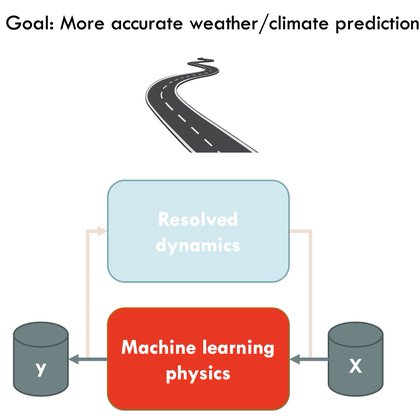
Stephan Rasp
@raspstephan
Followers
2K
Following
2K
Media
51
Statuses
523
Developing the next generation of weather and climate models @GoogleDeepMind
Munich, Germany
Joined November 2018
Excited to announce our new experimental cyclone model and a partnership with @NHC_Atlantic! Traditionally, it's been hard for a model to predict tracks & intensities: one requires a global view, the other very high resolution. Our AI model achieves strong performance on both.
We’re using AI to improve cyclone prediction. 🌀 Introducing Weather Lab: a new interactive platform developed with @GoogleResearch, hosting our experimental AI weather model which can predict a cyclone’s track, intensity, size and structure. Here’s how it works. 🧵
2
6
26
Other minor updates: - Where available, we added 2022 as an eval year in the interactive graphics. - We added forecast activity as a metric for deterministic models, a simple measure of blurring. - More regions. Don't hesitate to file bugs or suggestions as GitHub issues. end/
0
0
4
Next, we added 4 new models to the public benchmark (which now also uses WB-X as a backend): - GenCast - Stormer - Excarta (HEAL-ViT) - ArchesWeather The probabilistic scorecard finally looks a little more populated :) 4/
1
1
9
To get started, check out the documentation: https://t.co/EMXvGWpbIm For an example of evaluating forecasts against sparse observations, see: https://t.co/wxJdpAmUy5 Please don't hesitate to ask questions or report bugs/feature requests via a GitHub issue :) 3/n
1
0
4
WB-X is a complete rewrite of our evaluation code. We designed it to be as modular and powerful as possible with cutting-edge use cases like observation-based models in mind. We've used WB-X internally over the last year for most of our model development. 2/n
1
0
2
🚨 WeatherBench Update 1. WeatherBench-X, our new evaluation code, is now on GitHub: https://t.co/5yEB1aD8f2 2. New models (plus other small updates) on the WeatherBench website: https://t.co/f50rGD4e2i 1/n
sites.research.google
1
4
33
2025 is here tomorrow, so let's reflect on 2024. Even without the final counts and the new AMS and AGU ML journals, 2024 has eclipsed 10% of all papers and had over 600 papers mentioning neural networks in their abstracts 📈
1
3
27
What is the conclusion from GraphDOP being so far away from SotA? Is the setup still suboptimal in some way or is pure obs-based forecasting harder than some might have thought.
0
0
0
ECMWF with two new papers right before christmas. AIFS-CRPS: https://t.co/qUS9hcwfj4 GraphDOP (the first truly end2end global weather model): https://t.co/wesDCwvwmR Here they are added to the SotA tracker: https://t.co/i0Sg61gWmF
2
7
39
Interestingly, the first observation-based models, Aardvark and FuXi Weather, (even though both still use ERA5 as a training crutch) are roughly where ERA5 initialized models were 4 years ago. Similar progress incoming?
0
0
0
Here is an updated version of my chart showing the progress of AI-weather models over time. For details, including raw data and links to sources, check out this spreadsheet (feedback welcome 😀): https://t.co/i0Sg61gox7
2
8
45
Our new paper in @NatMachIntell tells a story about how, and why, ML methods for solving PDEs do not work as well as advertised. We find that two reproducibility issues are widespread. As a result, we conclude that ML-for-PDE solving has reached overly optimistic conclusions.
7
107
492
Genuine question: What is the best evidence for the value of physics-based regional weather/climate modeling? WRF certainly "looks" more realistic, but when is it actually consistently quantitatively superior to statistical post-processing of global models?
15
4
37
So question remain but maybe one lesson from this "AI revolution" is to be less skeptical and keep pushing the boundaries. Who would have though we are where we are now just a few years ago? end/
0
1
10
For longer-range prediction or even climate, the long runs from the NeuralGCM paper are very encouraging but naturally it's not a full climate model yet (missing all non-atmospheric components) plus extrapolation to future climate is still an open question. 5/
1
0
3
Of course, NeuralGCM doesn't solve all problems. For short and medium-range weather forecasting pure AI approaches might be simpler and more flexible; on the other hand, implicit or explicit DA could be easier with NeuralGCM if it is less prone to overfitting. 4/
1
0
3
The result is that NeuralGCM is truly unique among the swarm of pure AI weather models. The weather forecasting results are impressive (see WeatherBench 2) but what's more exciting is that the hybrid approach potentially allows for other applications. https://t.co/f50rGD3GcK 3/
sites.research.google
1
0
3
I mentioned a differentiable dycore as one principled way forward but never thought that someone would actually try it any time soon given that it was orders of magnitude more complex than existing differentiable solvers at the time. 2/
2
0
6
NeuralGCM is the result of persistence and long-term vision from @shoyer and the team. 4 years ago I wrote a blog post on the difficulties of building hybrid weather/climate models as all approaches back then were trained "offline". https://t.co/7mlSAFolEp 1/
raspstephan.github.io
The argument goes like this: Climate models continue to have large uncertainties → these uncertainties are primarily caused by the parameterization of sub-grid clouds which are based on heuristic...
I'm incredibly proud to share NeuralGCM, our new AI and physics based approach to weather and climate modeling with state-of-the-art accuracy, published today in @Nature: https://t.co/rtQa0Lq0fT
2
7
99







